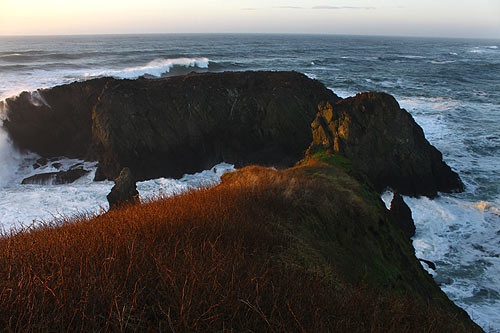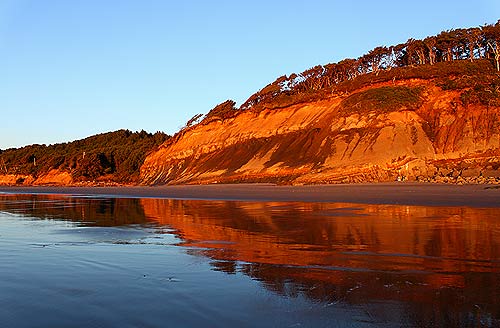Oregon Coast Science: New Whale Tech, Wave Energy Test Facility
Published 12/27/2016 at 5:53 PM PDT - Updated 12/27/2016 at 6:03 PM PDT
By Oregon Coast Beach Connection staff

(Newport, Oregon) – A lot of new and eye-opening developments are coming out of the Hatfield Marine Science Center and its parent institution, Oregon State University (OSU). Announcements this week include a massive wave energy test facility that will be built off the central Oregon coast and some new technology is providing engaging discoveries about whales. (Above: new whale tag tech, photo courtesy OSU).
This week, OSU's Northwest National Marine Renewable Energy Center was awarded up to $40 million from the U.S. Department of Energy, to create the world’s largest wave energy test facility off the central Oregon coast, near Newport. The Pacific Marine Energy Center South Energy Test Site (PMEC-SETS) is planned to be operational by 2020.
The offshore facility will test wave energy “converters” that harness the energy of ocean waves and turn it into electricity. Companies around the world are already anticipating construction of the new installation to test their own technologies in what is anticipated to be the most sophisticated and advanced of its kind.

Belinda Batten, the director of NNMREC and a professor in the OSU College of Engineering, said this kind of facility is complex and expensive. It has to continue working in extremely hostile conditions, including the kind of storm event that could only come around every 100 years. It will include four test berths connected to energy grids, all on the open water.
When it announced the award, the DOE noted that more than 50 percent of the U.S. population lives within 50 miles of coastlines, offering America the potential to develop a domestic wave energy industry that could help provide reliable power to these coastal regions. This work in marine and hydrokinetic energy technology is expected to increase domestic manufacturing and thus create jobs in those industries as well as in the burgeoning wave energy industry itself.
The new cutting-edge facility already has the enthusiastic support from various Oregon political figures, including Gov. Kate Brown, Ron Wyden, Jeff Merkley, Kurt Schrader and Suzanne Bonamici.
Scientists from the Oregon coast are using new and very cutting-edge technology to study whales – a type of tag that can record data for weeks and provide deeper insights into whale behavior. Researchers from OSU and its coastal facility the Hatfield Marine Science Center (in Newport) are touting its use in a new study on the “Advanced Dive Behavior,” or ADB tag, which is able to track whales at deeper depths than before and over thousands of miles of travel.
The tag can hold fast to the creature as long as seven weeks, eventually detaching from the whale, at which point researchers retrieve it.
Among those utilizing the device is Bruce Mate, professor and director of OSU’s Marine Mammal Institute in the College of Agricultural Sciences, headquartered at Newport's Hatfield. Among the new discoveries are:
Sperm whales are diving all the way to the sea floor, more than 1000 meters deep, and being submerged for up to 75 minutes. It showed baleen whales lunging after their food. It also provided some better understand of whales' reactions to undersea noises such as sonar or seismic exploration.
The ABD is even giving some new insight into water temperature changes and climate change.
Oregon Coast Hotels in these areas - Where to eat - Maps - Virtual ToursMore on Newport below:




More About Oregon Coast hotels, lodging.....
More About Oregon Coast Restaurants, Dining.....
Cannon Beach Lodging
Nehalem Bay Lodgings
Manzanita Hotels, Lodging
Three Capes Lodging
Pacific City Hotels, Lodging
Lincoln City Lodging
Depoe Bay Lodging
Newport Lodging
Waldport Lodging
Yachats Lodging
Oregon Coast Vacation Rentals
Oregon Coast Lodging Specials
LATEST Related Oregon Coast Articles
Likely just before dawn best hour but peak happens during daylight. Weather
Dark Sky Week is Prime Along Oregon Coast: Where and Where Not to Go
General guide to dark sky viewing from south to north coast. Astronomy
Sizable Price Drop, Deals in Lincoln City During Quiet of April on Central Or...
20 perc off at A1 Vacation Rentals across its roster, including Gleneden Beach. Lincoln City specials
Upcoming S. Oregon Coast Events Include Gem Show, History: Coos Bay, Bandon
May 6 talk at Coos History Museum, Mayfly Fest May 17, Bandon Rock / Gem Show June 7,8
Washington Coast Cleanup on April 19 - Coinciding with Oregon Coast's SOLVE E...
From the Puget Sound to Long Beach, alongside Oregon's cleanup. Washington coast events, Seaside events
Astoria's Riverwalk Gets New Lighting, More N. Oregon Coast Roadwork
Delays coming this summer, but the riverwalk has a new look. Seaside, Cannn Beach
April Gets Even Cheaper Midweek at Depoe Bay, Lincoln City: Oregon Coast Deals
Off-season rates plus more at Keystone Vacation Rentals. Depoe Bay lodging specials, Lincoln City hotel reviews, Newport hotel reviews
Washington Coast Begins Week of Clam Digs, April 12 Through 18
Long Beach, Twin Harbors, Mocrocks and Copalis at different times. Washington coast events
Back to Oregon Coast
Contact Advertise on BeachConnection.net
All Content, unless otherwise attributed, copyright BeachConnection.net Unauthorized use or publication is not permitted













































